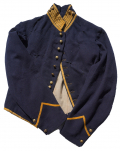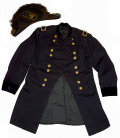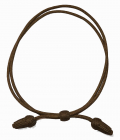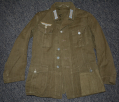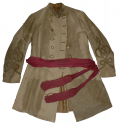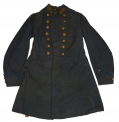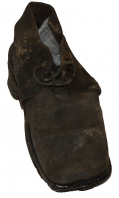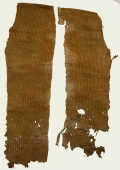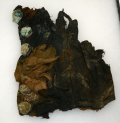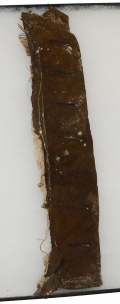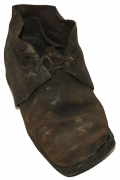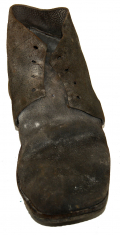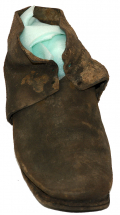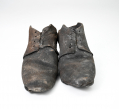site search
online catalog
Uniforms
Showing 61 to 80 out of 131
UNION CAVALRY SHELL JACKET
The m1858 Mounted Services Jacket - trimmed in yellow - was ubiquitous among Federal Cavalry Troopers during the Civil War and into the West as a standard issue item. One of the war’s most… (2024-1844). Learn More »
$1,895.00
ON HOLD
MINT IDENTIFIED BREVET BRIGADIER GENERAL’S FROCK COAT AND CHAPEAU OF ALONZO ALDEN
This sets consists of Brevet Brigadier General Alonzo Alden’s mint condition brigadier general’s frock coat with shoulder straps and his full dress “light French chapeau,” allowed for officers… (1179-156). Learn More »
OFFICER’S GOLD TONE HAT CORD, ID’D TO COL. WILLIAMS, 9TH PA. CAVALRY
woven gold bullion cord, adjuster slide, and acorns. All in very fine condition. This has a verbal identification to Colonel Edward Williams, 9th Pennsylvania Cavalry. Author/historian Randy… (1256-108). Learn More »
WWII JAPANESE LEG WRAPS (PUTTEES)
Wraps and ties do not look to haven been shortened and there is a good amount of use war to them. There is a good bit of fraying on the edges of the wraps and the end of the ties. There is a white tag… (1235-258). Learn More »
VETERAN BRING BACK GERMAN "AFRIKA CORPS" TUNIC
This enlistedman's open-collared field blouse is the style developed in 1940 in anticipation of deployment of German forces to North Africa under Irwin Rommel. This jacket of mid-brown canvas/cotton… (1235-453). Learn More »
$3,200.00
Originally $3,500.00
EXCELLENT CONDITION UNION ARTILLERY SHELL JACKET
Standard issue dark blue wool shell jacket with red piping on collar and cuffs with red trim down the front and along the edges. Jacket has 12 General Service eagle buttons down the front with two… (1179-160). Learn More »
$2,750.00
ON HOLD
WORLD CLASS IDENTIFIED WOUNDED IN ACTION CIVIL WAR NORTH CAROLINA SOLDIER’S JACKET WITH BULLET HOLE FROM HIS WOUND AT THE WILDERNESS!
Formerly in the collections of the Texas Civil War Museum this world-class Confederate infantryman’s jacket worn by William B. Royal came directly out of the family in 2002, having been previously… (814-69). Learn More »
WWII GERMAN WINTER MITTENS
Mittens show little age and use wear. The string to hang them around your neck is still attached. The markings are on the white side and are a little blurry. The insides are feldrgrau [green grey]… (1235-152). Learn More »
CONFEDERATE CAVALRY CAPTAIN’S FROCK COAT OF CAPT. EDWARD BIRD, “EFFINGHAM HUSSARS,” 2nd BATTALION AND 5th REGIMENT GEORGIA CAVALRY
This rare, identified, Confederate cavalry captain’s frock coat belonged to an officer who served from 1861 though 1865, rising from Captain to Colonel, with extensive action especially in… (1179-232). Learn More »
IDENTIFIED CONFEDERATE CAPTAIN’S FROCK COAT OF CAPTAIN PHARES WALDO SHEARER, 45th MISSISSIPPI, WITH 28-PAGE REMINSCENCES AND VETERAN’S BADGE- HE EXCHANGED SALUTES WITH THE WOUNDED JOHN BELL HOOD AT CHICKAMAUGA
This coat came directly out of the family along with a reunion badge and type-written copy of the officer’s 1906 reminiscences. The coat was formerly in the collection of Steve Mullinax, is… (1179-179). Learn More »
SCARCE CIVIL WAR ARMY ISSUE SHOE, A.K.A. BROGAN OR BOOTTEE
This Civil War US army issue shoe is typical wartime construction, using rough-side out black leather with reinforcing heel piece or “counter” sewn inside, four pairs of holes for a leather lace,… (1052-282). Learn More »
KNIT DRAWERS OR TROUSERS FROM FORT PEMBINA
These pieces are two legs from trousers or, more likely, drawers recovered in the excavations at Fort Pembina, ND, conducted on private property with the owner’s permission, where wet, anaerobic… (1052-446). Learn More »
CIVIL WAR-INDIAN WAR UNIFORM COAT PIECE WITH BUTTONS FROM FORT PEMBINA
This comes from the right lapel of a US army coat discarded by a soldier at Fort Pembina, ND, sometime between 1870 and 1895, and is from excavations in wet, anaerobic soil that has preserved leather… (1052-580). Learn More »
INDIAN WAR FIELD-USED CAMPAIGN HAT FROM FORT PEMBINA, NORTH DAKOTA
This is a real field-used Indian War campaign hat in relic condition excavated at Fort Pembina, ND, a small frontier army post in operation from 1870 to 1895. Anaerobic conditions of the dig have… (1052-253). Learn More »
US ARMY DRESS COAT LAPEL FROM FORT PEMBINA, ND
This coat lapel comes from the left side of US army dress coat discarded by a soldier at Fort Pembina, ND, and was excavated in wet, anaerobic soil that has preserved leather and cloth in remarkable… (1052-589). Learn More »
SCARCE CIVIL WAR ARMY ISSUE SHOE MADE AND MARKED BY CIVIL WAR CONTRACTOR JOHN MUNDELL OF PHILADELPHIA
This is a typical, though very scarce, Civil War issue army shoe made by a known contractor and marked by him on the inside of the ankle: “J. MUNDELL.” Mundell was born in Ireland in 1829, reached… (1052-298). Learn More »
SCARCE CIVIL WAR ARMY ISSUE SHOE, A.K.A. BROGAN OR BOOTTEE
This Civil War US army issue shoe is typical wartime construction, using rough-side out black leather with reinforcing heel piece or “counter” sewn inside, four pairs of holes for a leather lace… (1052-285). Learn More »
SINGLE SHOULDER STRAP FOR A CAPTAIN OF STAFF
Strap is made of dark blue cloth with a double row of dead bullion for a border. The rank field is of black velvet while the rank of captain is made of bars of heavy gold bullion thread. The underside… (460-1468). Learn More »
SCARCE CIVIL WAR ARMY ISSUE SHOE, A.K.A. BROGAN OR BOOTTEE
This Civil War US army issue shoe is typical wartime construction, using rough-side out black leather with reinforcing heel piece or “counter” sewn inside, four pairs of holes for a leather lace… (1052-300). Learn More »
INDIAN WAR ARMY SHOES BY MUNDELL FROM FORT PEMBINA, ND
This pair of shoes is from the excavations at Fort Pembina, ND, and could be taken for attic or barn-finds, having been preserved by the wet, anaerobic soil conditions of the dig. They are solid, can… (1052-387). Learn More »
Showing 61 to 80 out of 131
Most Popular
Historical Firearms Stolen From The National Civil War Museum In Harrisburg, Pa »
Theft From Gravesite Of Gen. John Reynolds »
Selection Of Unframed Prints By Don Troiani »
Fine Condition Brass Infantry Bugle Insignia »
Large English Bowie Knife With Sheath 1870’S – 1880’S »
Imported (Clauberg) Us Model 1860 Light Cavalry Officer's Saber »
featured item
CAPTURED CONFEDERATE SECOND NATIONAL FLAG, UNUSUAL VARIATION WITH MADAUS LETTER, FROM A SOLDIER IN THE 59th NEW YORK
This 2nd National Confederate Flag was purchased in the 1980s by a well-respected Florida dealer/collector directly from descendants of the Union soldier who had kept it as a trophy. It comes with a 1988 letter on Milwaukee Public Museum letterhead… (1179-019). Learn More »



